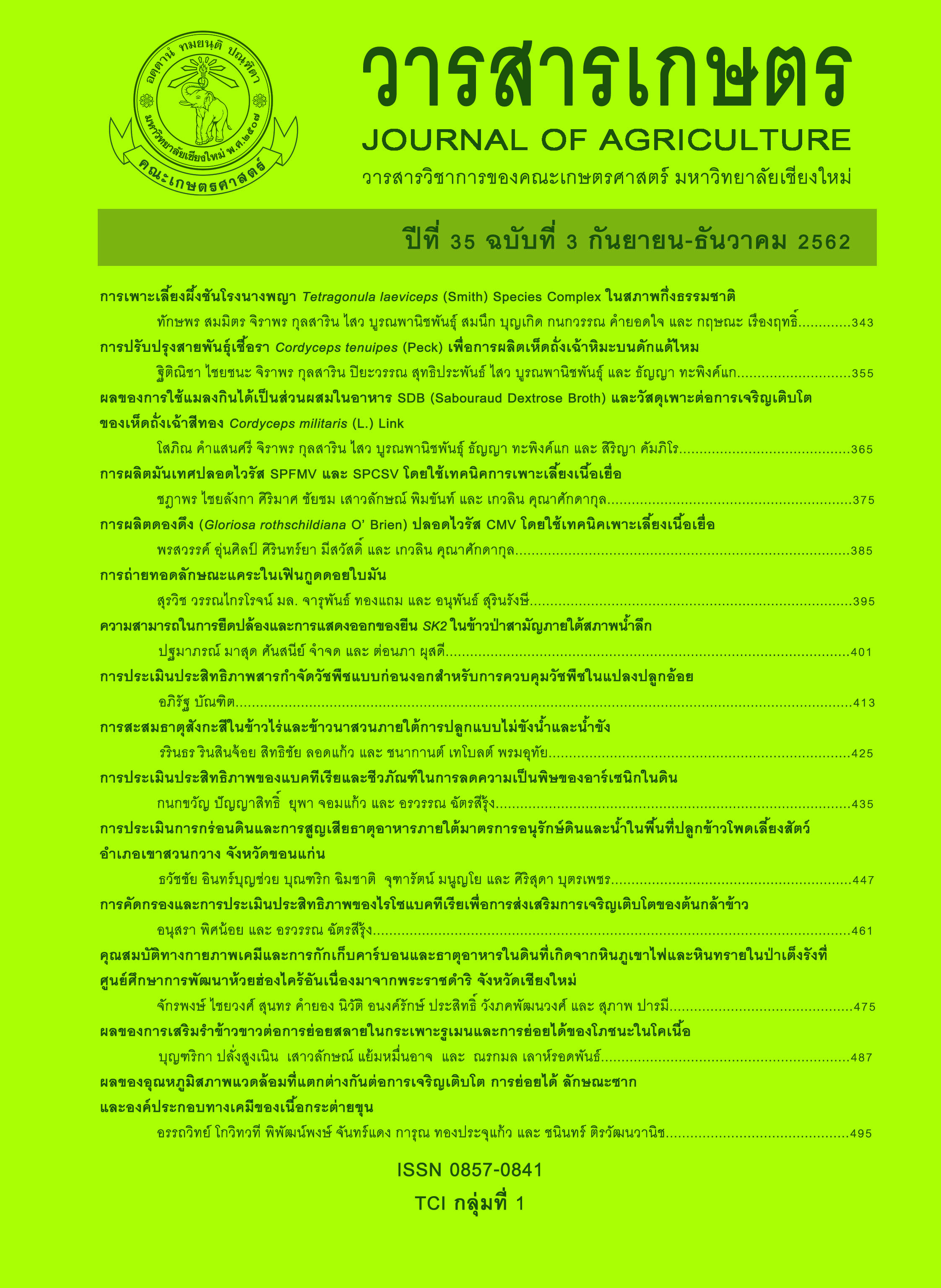Efficiency Evaluations of Bacteria and Bio-products in Reducing Arsenic Toxicity in Soils
Main Article Content
Abstract
Microbial reduction of arsenic (As) plays an important role in arsenic (As) detoxification in contaminated soils. Arsenic reducing microorganisms i.e. isolate BPAs17 and FPAs24 were isolated from arsenic-contaminated soils, exhibited high potential in As resistance. In this study, therefore, the two isolates were used to test their effectiveness in soil-arsenic reduction. Preliminary study showed that liming for pH adjustment together with microbial application resulted in As reduction in all the treatments. Liming with BPAs17 application gave the highest reduction of As in soil. Therefore, isolate BPAs17 was used to evaluate its survival in three types of carriers. The results showed that mixed media (MMC) gave the highest BPAs17 population at all stages of incubation. From the results of the experiments, isolate BPAs17 was selected to mix with MMC to produce bio-product prototype. The bio-product was then used to test its effectiveness to reduce As in soils with initial As concentration of 50 mg/kg. The results showed that soil pH adjustment with the application of bio-product gave the highest reduction of As at both 7 and 30 days after incubation with the reduced values of only 24.7 and 20.8 mg/kg, respectively (reduction percentage of -50.6 and -58.5%, respectively). The results of the present investigation indicated that bio-product prototype could be applied for management of As contaminated soils.
Article Details
References
Center of Excellence on Hazardous Substance Management. 2007. Study of heavy metals contents in soil and sugarcane grown in central, northern and north-eastern. Final report. Chulalongkorn University, Bangkok. 98 p. (in Thai)
Duangpatra, P. 2010. Soil Conditioners. Kasetsart University Press, Bangkok. 256 p. (in Thai)
Feng, Q., Z. Zhang, Y. Chen, L. Liu, Z. Zhang and C. Chen. 2013. Adsorption and desorption characteristics of arsenic on soils: kinetics, equilibrium, and effect of Fe(OH)3 colloid, H2SiO3 colloid and phosphate. Procedia Environmental Sciences 18: 26-36.
Katsoyiannis, I., A. Zouboulis, H. Althoff and H. Bartel. 2002. As(III) removal from groundwaters using fixed-bed upflow bioreactors. Chemosphere 47(3): 325-332.
Khummalai, N., S. Jarudilokkul and V. Boonamnuayvitaya. 2000. Bioremediation of arsenic contaminated soil in the southern of Thailand. Pp. 349-360. In: Proceedings of the 10th Thai Institute of Chemical Engineering and Applied Chemistry. BITEC, Bangkok. (in Thai)
Kremer, R.J. and H.L. Peterson. 1983. Effects of carrier and temperature on survival of Rhizobium spp. in legume inocula: development of an improved type of inoculant. Applied and Environmental Microbiology 45(6): 1790-1794.
Land Development Department. 2010. Handbook of Soil Chemical Analysis. Document No. OSD-03. Land Development Department, Bangkok. 51 p. (in Thai)
Mandal, B.K. and K.T. Suzuki. 2002. Arsenic round the world: a review. Talanta 58(1): 201-235.
Matschullat, J. 2000. Arsenic in the geosphere - a review. Science of the Total Environment 249: 297-312.
Naher, U.A., F. Rahman, S.M.M. Islam, M.I.U. Sarkar and J.C. Biswas. 2015. Isolation of arsenic oxidizing-reducing bacteria and reclamation of As(III) in in vitro condition. Bangladesh Rice Journal 19(2): 99-101.
Nateewattana, J. 2012. Technology used for environmental arsenic remediation. Naresuan Phayao Journal: Health Science, Science and Tachnology 5(3): 258-270. (in Thai)
Ojuederie, O.B. and O.O. Babalola. 2017. Microbial and plant-assisted bioremediation of heavy metal polluted environments: A review. International Journal of Environmental Research and Public Health 14(12): 1504, doi:10.3390/ijerph14121504.
Pollution Control Department. 1998. Arsenic. Integrated Promotion Technology Company, Bangkok. 52 p. (in Thai)
Pinter I.F., M.V. Salomon, F. Berli, R. Bottini and P. Piccoli. 2017. Characterization of the As(III) tolerance conferred by plant growth promoting rhizobacteria to in vitro-grown grapevine. Applied Soil Ecology 109: 60-68.
Sharma, V.K. and M. Sohn. 2009. Aquatic arsenic: toxicity, speciation, transformations, and remediation. Environmental International 35(4): 743-759.
Shutsrirung, A. 2003. Characterization of native bradyrhizobia in soybean-growing areas of northern Thailand. Ph.D. Thesis. Mie University, Mie, Japan. 150 p.
Shutsrirung, A. 2012. Selection of microorganism in highland for soil quality improvement in acid and high arsenic soils. Final report. Highland Research and Development Institute (Public Organization), Chiang Mai. 56 p. (in Thai)
Shutsrirung, A. 2015. Research and development of bio-substances for reducing toxicity of residue substances in soils. Final report. Highland Research and Development Institute (Public Organization), Chiang Mai. 60 p. (in Thai)
Shutsrirung, A. 2016. Research and development of bio-substances for reducing toxicity of residue substances in soils. Final report. Highland Research and Development Institute (Public Organization), Chiang Mai. 70 p. (in Thai)
Toxicology Information Center. 2002. Danger and toxicity of arsenic. (Online). Available: https://webdb.dmsc.moph.go.th/ifc_toxic/a_txR_search.asp?info_id=121 (April 8, 2017). (in Thai)
Vidali, M. 2001. Bioremediation: an overview. Pure and Applied Chemistry 73(7): 1163-1172.
Wisawapipat, W. 2012. Remediation technologies of heavy contaminated soils using phosphate materials. Khon Kaen Agriculture Journal 40(4): 373-378. (in Thai)
Woodruff, C.M. 1948. Determination of the exchangeable hydrogen and lime requirement of the soil by means of the glass electrode and a buffer solution. Soil Science Society of America Proceedings 12: 141-142.


